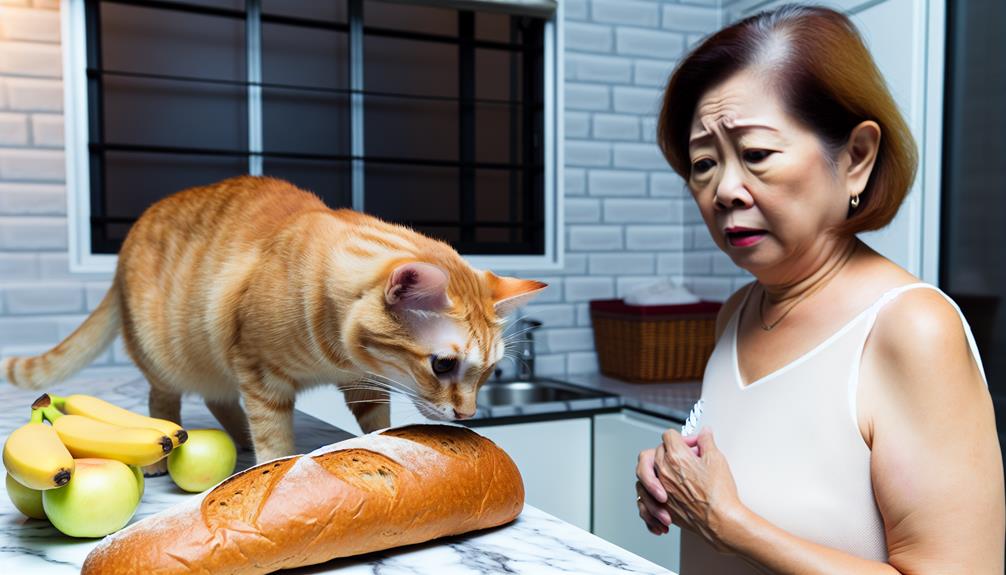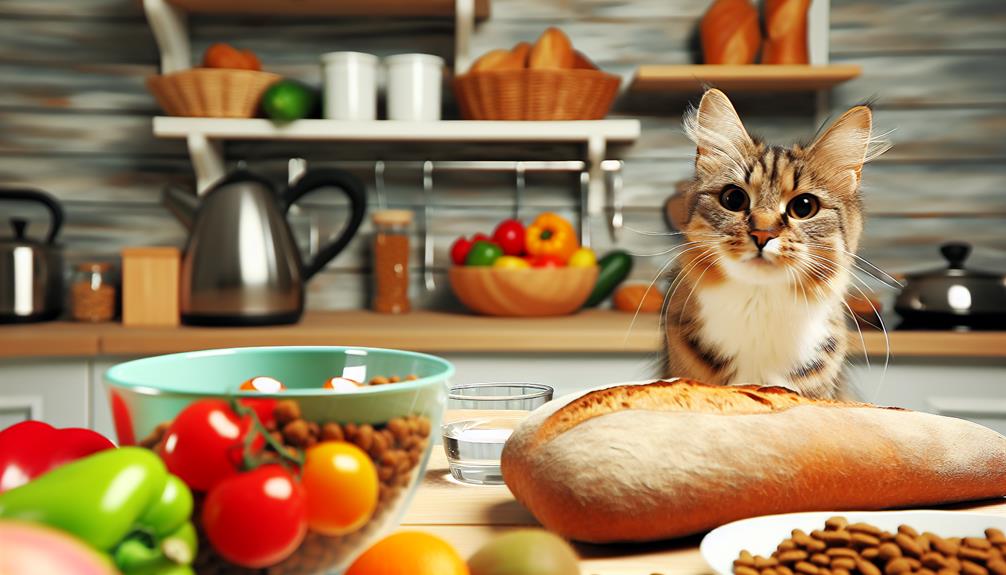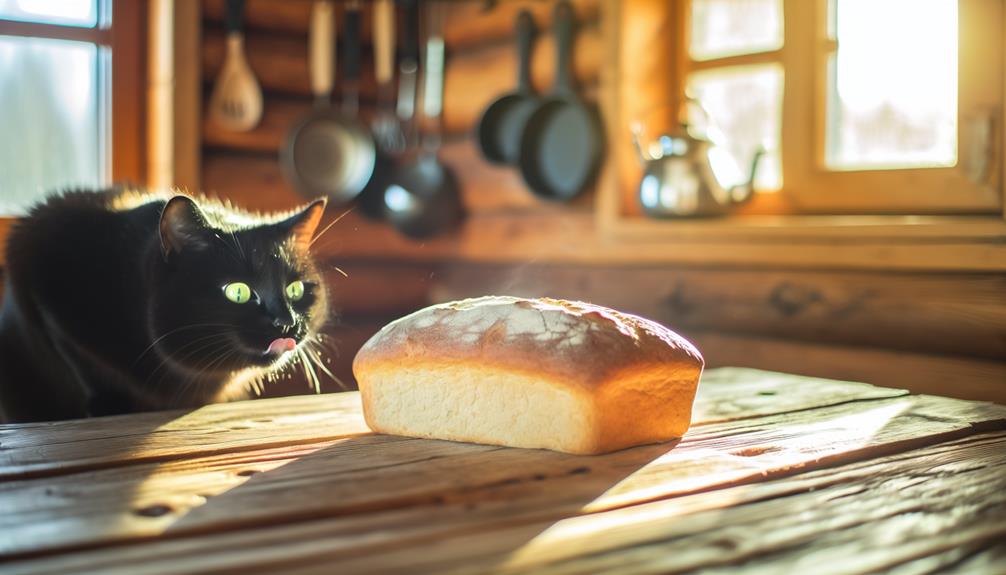Did you know that cats are obligate carnivores, meaning more than 70% of their diet should come from meat? You might wonder if that means bread is off the menu entirely for your feline friend. While cats can technically eat bread in moderation, it's not exactly beneficial for their health. Before you decide to share your toast with your pet, it's essential to understand the potential risks and minimal benefits. What do common bread ingredients mean for their digestion, and are there any safe types of bread to take into account? Let's explore these questions further.
Nutritional Needs of Cats
When examining the nutritional needs of cats, it's crucial to understand that they are obligate carnivores, meaning their diet must consist mainly of meat to meet their physiological requirements. This dietary necessity stems from their evolutionary history and unique metabolic processes. Cats require a variety of essential nutrients that are primarily found in animal tissues, making a meat-based diet critical for their health.
You can't overlook the importance of protein in a cat's diet. Cats need higher protein levels than many other animals, with amino acids like taurine being vital. Taurine, found almost exclusively in animal flesh, is necessary for heart function, vision, and reproduction. A deficiency in taurine can lead to severe health issues, such as dilated cardiomyopathy or retinal degeneration.
Fats also play a crucial role in feline dietary requirements. They provide energy and support the absorption of fat-soluble vitamins like A, D, E, and K. Omega-3 and Omega-6 fatty acids, essential for maintaining healthy skin and coat, are also derived from animal sources.
Furthermore, cats need certain vitamins and minerals that are best obtained through a meat-based diet. For instance, Vitamin A in its preformed state (retinol) and Vitamin B12 are readily available in animal tissues but not in plant matter. Without these nutrients, cats can suffer from various deficiencies, leading to compromised immune function and neurological problems.
Common Ingredients in Bread
Understanding the specific dietary needs of cats, particularly their dependence on meat-based nutrients, brings into question the suitability of non-meat foods like bread in their diet. Bread, a staple in many human diets, contains a variety of ingredients that could affect cats differently. Let's examine the common ingredients found in different bread types to understand their potential impact.
- Flour: The primary ingredient in most bread types, flour is derived from grains like wheat. While it's a source of carbohydrates, cats don't require a carbohydrate-heavy diet, as their natural diet is high in protein and fat. Consequently, flour doesn't offer significant nutritional benefits for felines.
- Yeast: Used for leavening, yeast is generally safe for cats in small amounts. However, raw yeast dough poses risks (which we won't discuss here). Cooked yeast in bread is less of a concern, but it doesn't contribute to the essential nutrients cats need.
- Salt: Though essential in small quantities for all animals, excessive salt can be harmful to cats. Bread often contains added salt, which can accumulate if bread becomes a regular part of your cat's diet, potentially leading to health issues.
- Sweeteners: Some bread types include sweeteners like sugar or honey. Cats lack taste receptors for sweetness, making these ingredients unnecessary for their diet. Additionally, excessive sugar can lead to obesity and other health problems.
Risks of Feeding Bread

Feeding bread to cats poses several risks that pet owners should be aware of. Bread is not a natural part of a cat's diet, and its consumption can lead to various health concerns. One primary issue is digestive problems. Cats are obligate carnivores, meaning their digestive systems are optimized for processing meat, not carbohydrates or yeast found in bread. When a cat consumes bread, it may experience gastrointestinal upset, including vomiting, diarrhea, and abdominal discomfort. In some cases, the yeast in bread can ferment in a cat's stomach, causing bloating and gas, which can be particularly uncomfortable and even dangerous.
Another significant risk is the potential for allergic reactions. Some cats may be allergic to ingredients commonly found in bread, such as wheat, dairy, or certain preservatives. Symptoms of an allergic reaction can range from mild to severe and may include itching, skin rashes, swelling, and respiratory issues. Identifying and managing food allergies in cats can be challenging, often requiring dietary adjustments and veterinary consultations.
Additionally, bread can contribute to weight gain and obesity in cats. Bread is calorie-dense and lacks essential nutrients that cats need to thrive. Over time, feeding bread can lead to an imbalance in their diet, predisposing them to obesity and related health issues such as diabetes and joint problems.
Possible Benefits of Bread
Despite the risks associated with feeding bread to cats, there are some potential benefits under specific circumstances. While it's not a staple in feline diets, certain aspects of bread can offer minor advantages if given in moderation and under appropriate conditions.
- Palatability and Texture: The bread texture can be appealing to some cats, providing a different sensory experience compared to their regular diet. This can be particularly useful for picky eaters or cats that need encouragement to eat.
- Temporary Filler: In cases where you're shifting your cat to a new diet, a small amount of bread can act as a temporary filler. The fiber content can help in easing the change, although it shouldn't replace any essential nutrients from their primary food.
- Aiding Digestion: Bread contains a modest amount of fiber, which can assist feline digestion. This could be beneficial for cats experiencing mild constipation, as a tiny bit of fiber can help to regulate their digestive system. However, it's essential to monitor their reaction, as too much fiber might cause adverse effects.
- Medication Administration: Bread can be a handy tool for administering medication. If your cat struggles with taking pills, hiding the medication in a small piece of bread might make the process easier. The soft bread texture can mask the pill, making it more likely that your cat will ingest the medication without fuss.
Safe Bread Types

When it comes to deciding which types of bread are safe for your cat, it's important to focus on simplicity and ingredient transparency. Cats have unique dietary needs, and while bread isn't a natural part of their diet, some types can be safer than others. Opting for whole grain and gluten-free varieties can be a good starting point. Whole grain bread usually contains more fiber and fewer additives, making it less likely to upset your cat's digestive system.
Here's a quick guide to understanding safe bread types:
| Bread Type | Safe for Cats? | Notes |
|---|---|---|
| Whole Grain | Yes | Offers fiber, fewer additives |
| Gluten-Free | Yes | Avoids potential gluten sensitivity |
| White Bread | Limited | Lacks nutritional value, but generally safe |
| Sourdough | No | Fermentation can cause digestive issues |
| Flavored Bread | No | Often contains harmful ingredients like onions |
Whole grain bread stands out as the most favorable option due to its higher fiber content and fewer artificial ingredients. While cats don't require fiber in the same way humans do, it can help with digestion in small amounts. Gluten-free bread is another safe choice, especially if you're concerned about gluten sensitivity. However, always check for other ingredients that might be harmful.
White bread, although generally safe, offers little nutritional benefit and should only be given sparingly if at all. Sourdough and flavored breads should be avoided due to potential harmful effects from fermentation and added ingredients like onions or garlic, which are toxic to cats.
Bread Alternatives for Cats
While whole grain and gluten-free bread can be relatively safe for your cat in small amounts, you might be looking for more suitable alternatives that align better with your feline's nutritional needs. Cats are obligate carnivores, meaning their diet should primarily consist of meat. However, if you feel the need to offer them a special treat, there are several healthier options than bread.
- Homemade Bread for Cats: If you're set on giving your cat a bread-like treat, consider making homemade bread tailored for them. Use cat-safe ingredients like pureed meat and fish, avoiding seasonings, onions, or garlic. This guarantees your cat gets a protein-rich treat without harmful additives.
- Grain-Free Options: Many commercial cat treats available on the market are grain-free and designed to meet feline dietary requirements. These treats often contain high-quality protein sources and are free from unnecessary fillers that could upset your cat's digestive system.
- Cooked Meat: Plain, cooked meat such as chicken, turkey, or fish can serve as an excellent alternative to bread. Verify the meat is free from bones, seasoning, and sauces to avoid potential health risks. This aligns perfectly with your cat's carnivorous diet.
- Vegetables: Some cats enjoy vegetables like cooked carrots or peas. These can be given in small amounts and should be plain and unseasoned. While vegetables aren't a staple in a cat's diet, they can offer additional nutrients and act as a low-calorie treat option.
Tips for a Balanced Diet

To guarantee your cat's health, focus on providing nutrient-rich ingredients and maintaining portion control. It's essential to offer a variety of meals to meet their dietary needs and prevent nutritional deficiencies. By balancing these elements, you'll support your cat's overall well-being and longevity.
Nutrient-Rich Ingredients Only
A balanced diet for your cat should focus on nutrient-rich ingredients that cater to their specific dietary needs. While bread types and other human foods might seem harmless, it's important to prioritize what truly benefits your feline friend. Cats are obligate carnivores, which means their diet should be rich in animal-based proteins and fats. When considering ingredient sources, it's crucial to choose those that provide complete nutrition.
Here are four key components to include in your cat's diet:
- Animal Proteins: Guarantee the primary ingredient is high-quality meat like chicken, turkey, or fish. These proteins support muscle development and overall health.
- Taurine: This necessary amino acid is vital for heart and eye health. It's naturally found in meat, so a meat-based diet is critical.
- Healthy Fats: Omega-3 and Omega-6 fatty acids, found in fish oil and poultry fat, promote a shiny coat and healthy skin.
- Vitamins and Minerals: A balanced diet should include necessary vitamins (A, B, E) and minerals like calcium and phosphorus for bone health.
Steering clear of unnecessary fillers like certain bread types guarantees your cat gets the best nutrition possible. Always consult your vet when making dietary changes.
Portion Control Importance
Proper portion control is fundamental for maintaining your cat's health and preventing obesity. Overfeeding can lead to various health issues, including diabetes and joint problems. To guarantee your cat stays healthy, it's essential to be vigilant about portion sizes and feeding frequency.
Experts recommend measuring your cat's food to avoid guesswork. Use a kitchen scale or measuring cups to provide accurate portion sizes. Typically, a cat needs about 24-35 calories per pound per day, but this can vary based on age, activity level, and health status. Consult your veterinarian for personalized advice.
Feeding frequency also plays an important role. Instead of free-feeding, establish regular meal times. Most cats do well with two meals per day, which helps regulate their metabolism and prevents overeating. If your cat has special dietary needs, smaller, more frequent meals might be necessary.
Don't forget to account for treats and extras. Bread, if given, should be rare and in tiny amounts. Remember, a balanced diet is key, and each treat should fit within the daily caloric limits. By managing portion sizes and feeding frequency, you can help your cat lead a healthier, happier life.
Variety in Meals
While guaranteeing your cat enjoys a well-balanced diet, incorporating a variety of meals is essential for meeting their nutritional needs. Cats are obligate carnivores, meaning their diet should primarily consist of meat. However, adding diversity to their meals can enhance their overall health and well-being. Here are some tips to achieve treat variety and meal enrichment:
- Rotate Protein Sources: Alternate between different types of meat such as chicken, turkey, and fish. This prevents nutritional imbalances and keeps your cat interested in their food.
- Incorporate Wet and Dry Foods: Mixing both wet and dry cat food guarantees your cat gets adequate hydration and dental benefits. Wet food is great for moisture, while dry food can help maintain dental health.
- Add Fresh Ingredients: Occasionally add fresh, safe ingredients like small pieces of cooked chicken or salmon. These can provide extra nutrients and make meals more exciting.
- Use Food Puzzles: Implementing food puzzles or interactive feeders can make mealtime stimulating and mentally enriching, promoting natural hunting instincts and reducing boredom.
Conclusion
Feeding your cat bread is like offering a gourmet salad to a lion—it's not their natural diet. Cats thrive on meat-based nutrition, and while the occasional bread treat won't harm them, it's vital to avoid making it a regular part of their meals. Stick to high-quality, meat-rich foods to guarantee your feline friend stays healthy. Remember, moderation and balance are key to keeping your cat both happy and well-nourished.
